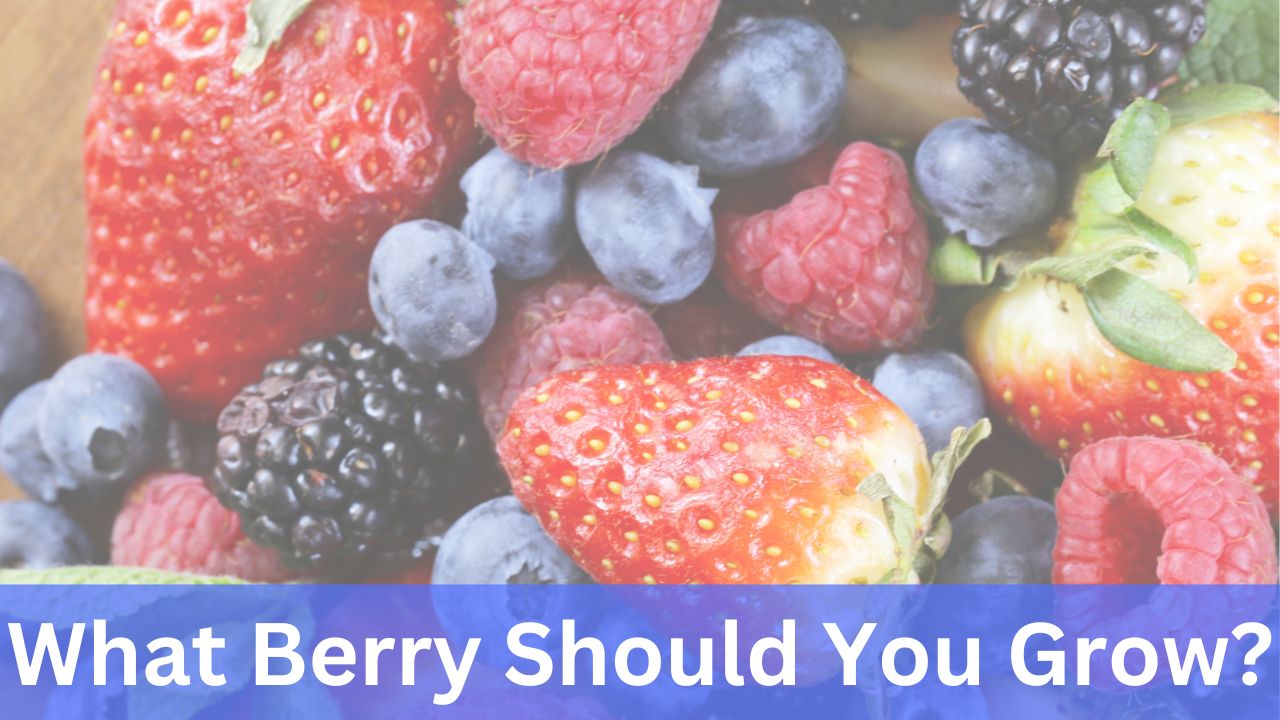What’s the best berry to grow and eat?
Blackberry, Blueberry, Red Raspberry, Strawberry.
Everyone has their favorite berry to eat, store, and grow. Sometimes it’s the same berry and sometimes it’s not. I love most berries, but on our homestead we concentrate on growing strawberries, raspberries, blueberries, and blackberries. Yes, we grow other berries as well, but these are our main eating and medicinal berries.
You may think it’s nuts to grow so many varieties of berries at one time, but you’d be wrong. Mainly because once the berry bushes have been established, there is very little that needs to be done with them because they are perennials. This means you plant them once, take care of them, and they give you fruit year after year after year.
Eating, storing, using:
All four of these berries are great for eating fresh, storing, and using throughout the year. There is nothing better than a fresh berry straight off the plant. However, all four types of berries can be stored for future use through canning, jams, freezing, dehydrating, and freeze-drying. All four berries defrost easily for use in smoothies, ice cream, pies, jams, to make vinegars, and much more.
The leaves of these four berry plants possess medicinal qualities and can be used in teas for their nutritional and health benefits.
So which berry is the best berry? That’s entirely up to you, your taste, and where you live. All four berries can be found in the wild and grown intentionally in your garden. You can grow these berries anywhere you choose, including in the ground and in pots. Plus, all these berries come in different varieties, sizes, and taste to suit your needs.
Here’s some information to help you decide which berry or berries you want to grow first.
Blackberry:
Using blackberries for food, medicine, and to dye with dates back thousands of years. Wild thorned blackberries can be found throughout the world including Mexico, United States, and Europe. Domesticated blackberries come in varieties of thorn and thornless.
Other names for the blackberry include bramble, brummel, and brambleberry. The loganberry is related to the blackberry.
They are a perennial plant, with biennial canes that shoot from the roots. The first year a shoot grows from the root, it doesn’t produce fruit. The second year the same shoot will produce fruit, then die back. The plant produces new shoots every year.
Growing:
Blackberries like well-drained acid soil between 5.5 and 6.5 pH. They grow well in hardiness zones of 5 – 9 with ease. Your blackberry plants will need a trellis or support to hold the canes off the ground. First year canes, when left to their own devices, will root themselves into the ground. This is ideal for those who want more blackberry plants without needing to buy them.
For maximum berries, tie the canes to a trellis. Or cut the plant back to about 4 to 5 feet tall and tie all the canes together to a stake for support.
Nutritional Information:
Protein, potassium, magnesium, Vitamin A, C, E, K, folate, calcium, iron, and polyphenols.
Blueberry:
American blueberries are related to the European Bilberry, as well as the cranberry. You can find wild blueberries in wooded areas, as well as growing them yourself.
They are a perennial bush, meaning they produce fruit year after year without needing to be replanted. Depending on the variety and how you prune them will determine the bush’s size. The berries vary in color from a blue to a deep purple.
Growing:
Blueberries like well-drained sandy acidic soil. They like full sun for optimal growth. If grown in pots, be sure to keep bushes well trimmed to fit the pot size. Trimming on outside plants should be done yearly once they are established.
They grow wild and domestically in hardiness zone 3 – 9.
Nutritional Information:
Vitamin C, B6, K, calcium, iron, potassium, magnesium, sodium, zinc, folate, copper, beta-carotene, folate, Vitamin A, and polyphenols.
Red Raspberries
They are also known as American Red Raspberries and European Red Raspberries. They are a a perennial plant with thorny woody stems. Red Raspberries and the leaves of the plant have been used for thousands of years for medicinal, beauty, and food.
They are a perennial plant which begins producing fruit the second year. At the end of each season, prune back the plant. Some gardeners prune them all the way to the ground, while others leave some shoots. Make sure you cut off any shoots that start growing in undesired areas. Red Raspberries can become invasive if you’re not careful.
Growing
Red Raspberries grow best in slightly acid to neutral pH well drained soil. They need to be tied to a trellis for easier picking and stabilizing the plant. They grow well in hardiness zones 3 – 10. In our area, which is a 5b hardiness zone, we’ve never planted a Red Raspberry plant, yet we have them throughout the garden and woods.
Nutritional Information:
Protein, Vit C, Manganese, Vit K, Vit E, Vit B, folate,Iron, magnesium, phosphorus, potassium, copper, selenium, and polyphenols.
Strawberries:
What we call wild strawberries have been documented back to about the 1300s. These strawberries still grow all over the world. They are a smaller fruit and plant then you typically see in a garden. By the early 1700s strawberry plants were being sent and brought to different regions and being crossed for a bigger strawberry. This bigger strawberry, now known as the garden strawberry, is available in many varieties.
The strawberry plant is a self-pollinating perennial. Self-pollinating means they do not need an insect or any outside force to help pollinate the flowers for fruit. Since they are a perennial plant, they will return year after year. However, after two to three years the berry harvest diminishes. Commercial strawberry growers replant new plants every two years.
As a gardener, this is not necessary. Every year your strawberry plants will send off runners, which are baby strawberry plants. Covering the bottom of the small plants with soil will aid in the new plants’ growth. Older plants can be removed as their production diminishes.
Types of Strawberry Plants
There are two types of strawberries, June bearing, and ever bearing or day neutral. Some information on the web make a distinction between ever bearing and day neutral. However, the organic farmer I spoke to said there really wasn’t a difference and it was more marketing because they grew the same. I don’t know if this is true in all areas or just the weather where we are located.
June bearing strawberries grow and ripen in early spring. Your weather will dictate when the strawberries actually bear fruit and ripen. Most berries ripen about the same time, giving you many fruit at one time.
Ever-bearing or day neutral strawberries give you fewer berries at once but for a longer period of time. In many areas, day-neutral plants give you a spring and a fall crop.
Growing:
New strawberries can be planted spring or fall. They like well drained soil with a pH around 5.5. to 6.5. You want to make sure the roots don’t get waterlogged, for they will rot and cause fruit to rot faster as well.
Personally, I plant my strawberry plants about 6 inches apart for growth. I push the runner to a parallel row 4 to 6 inches away from the original plant. I keep my strawberry sections narrow enough that I can straddle them to pick.
Before winter, in areas that get cold months, lightly cover with straw or something light without seeds. The plants will die back over cold months and need the covering, but you do not want to smother the plants.
If you live in hotter weather, you’ll need to protect your plants from heat. My father grew strawberries in the shade of our citrus trees when I was growing up.
Nutritional Information
Vitamin C, B6, K, E manganese, folate, potassium, polyphenols, copper, magnesium, phosphorous.
So which berry is best to eat and grow?
There is no cut and dry answer. It depends on your environment, taste, and weather. The blackberry, blueberry, red raspberry, and strawberry all have pro’s and cons of growing depending on your space. You can grow all of them in pots, balconies, and in a garden. Nutritionally and medicinally they all have great benefits too.
I say grow all of them. Even if it’s just a couple of plants of each berry. Start with your favorite berry, then add another variety or plant at a time.
You can’t go wrong with berries for your health, and belly.

